

EUIPO publishes the first study attempting to assess the dimension of GI infringements in the EU
On April 24, 2016 the European Union Intellectual Property Office (EUIPO) published the report on infringements of protected geographical indications (GIs) for agricultural products in the EU. A GI is an indication (usually a name) used on products having a specific geographical origin and possessing a given quality, reputation or other characteristic that is essentially attributable to that origin. The study was conducted from 2012 to 2015, with the aim to establish the size and value of the GI market in the EU, as well as the impact of infringements on EU customers. It included all protected GIs, coming from EU Member States and third counties, protected through registration or by an international agreement.
Size and value of the EU GI product market
The EUIPO database contains more than 4,800 protected GIs. Consumption of these goods in 2014 amounted to 48 billion EUR. The biggest consumers are also the biggest producers, namely France, Germany, Italy and the UK.
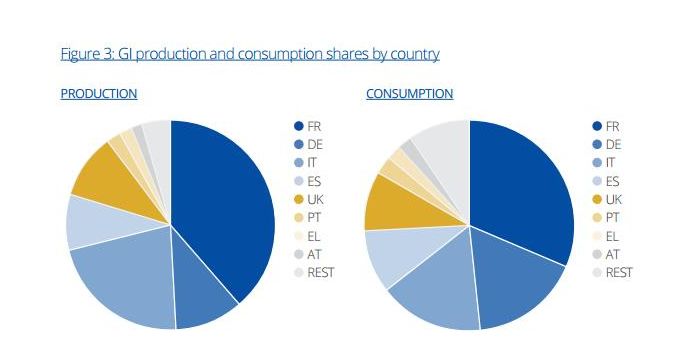
When observing the types of goods consumed, some light is shed why France has such a big role in the GI sector. The most consumed products are wine, spirits and cheese, all of which are considered as French delicacies.
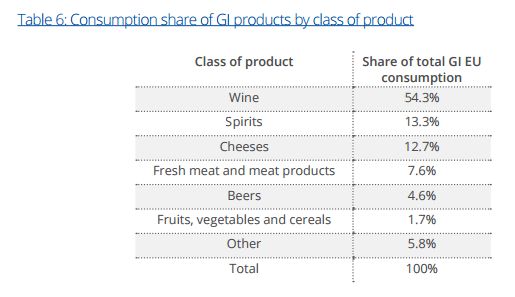
Almost one third of the GIs sold derive from ten leading products.
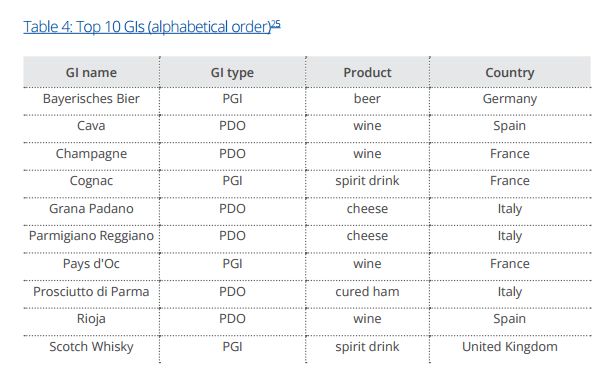
96% of consumed goods originated from the EU and 68% came from the same country where consumed. Only a small number of third country-produced products hold significance in the EU, such as Café de Colombia and Mexican Tequila, and their infringements are not as common as they are with the EU products. When it comes to exports, France, Italy and the UK are considered to be the European leaders of the group.
Infringements and their impact on EU customers
Studies have shown that agricultural GI products contribute to rural development. Also, they enhance smaller producers´ reputations, increasing their competence to compete with larger mass-producers. Next, it was proven that PDO and PGI logos are well recognized among EU consumers, inciting them to pay a higher price for the product. The occurring problem was the fragility of the reputation of GIs. One producer selling a lower-quality product led to a domino effect, with the consumer doubting all of his competitors too. Some cases have shown that consumers put more emphasis on supporting the local economy and promoting the authenticity of the product, than they do on the quality of the good.
Researching around 82% of the EU GI market, the results show that 9% of the market was covered by infringing goods, amounting to 4.3 billion EUR. More than half of that (4.8% of the total market) was done by unknowing customers, paying premium price for a product they believed to be a GI product. It is estimated that customers were at a loss of 2.3 billion EUR in total.
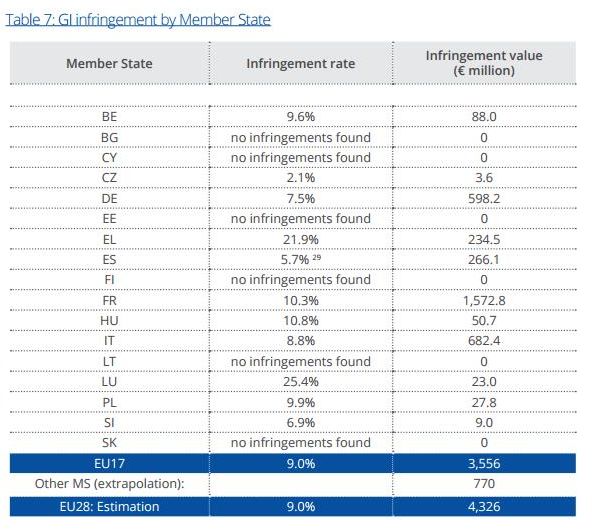
It is no surprise that the most consumed products are also the most common subjects of infringements. The biggest loss, more than 1.3 million EUR, is in found in the wine industry, although it is on the lower side of the spectrum when it comes to infringement rates. Combined with spirits, together they account for nearly 80% of total consumer loss.
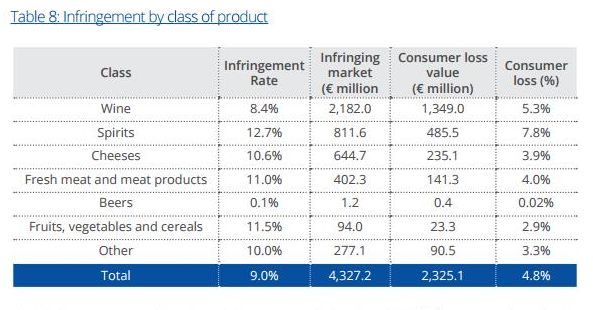
The study included false or misleading use of the protected GI and marketing of product not originating from the indicated place of origin. Most infringements were imitations with 42%, continued by misleading GI labels with 38%, and deception in product specifications (or differently put, the lack of quality promised) with 21% of total infringements.
Conclusions
EUIPO´s report is a valiant first attempt to grasp the extent of GI infringements in the EU. The results have shown to be less than satisfactory, and the next steps might be the expansion of the study to a global level, followed by the appropriate response by the European Union.
Related
- 1 December 2017: Madrid Monitor takes its place as the one and only tool for tracking international trademarks
- 1 January 2020 - Changes in Classifications - Trademarks, Designs, Patents and Utility Models
- 100th Anniversary of Bavaria (Germany) - A glance at trademarks, start-ups, innovation & events
- 10th Anniversary Edition - 10 Things to Know about LexDellmeier - Past, Present & Future
- 15 Years LexDellmeier - 2024 New Year Wishes
- 2024 World IP Day - Building Our Common Future with Innovation and Creativity
- A guide for influencers, Part 1: Protecting your own intellectual property
- A guide for influencers, Part 2: Minding the intellectual property of others
- A new legal EU framework regulating Artificial Intelligence
- All these small Gimmicks – Trademark Infringement?
